

Climate & Energy | Shared Resources. Why real estate needs Tesla-style buildings, used 'Uber-style' While the financial industry is still reeling from recent stock market gyrations, it is tempting to forget about long-term issues, such as extreme weather events, the rising sea levels and demographic change.

New California Laws are a Needed Paradigm Shift for Energy Efficiency. Greenland Is Melting Away. On the Greenland Ice Sheet — The midnight sun still gleamed at 1 a.m. across the brilliant expanse of the Greenland ice sheet.

Brandon Overstreet, a doctoral candidate in hydrology at the University of Wyoming, picked his way across the frozen landscape, clipped his climbing harness to an anchor in the ice and crept toward the edge of a river that rushed downstream toward an enormous sinkhole. If he fell in, “the death rate is 100 percent,” said Mr. Overstreet’s friend and fellow researcher, Lincoln Pitcher. But Mr. Amazon, data center turn hot idea into cool technology. Saving millions of kilowatt-hours a year, the innovative heat-transfer system between Amazon’s downtown high-rises and the region’s chief telecom hub could be a model for others.
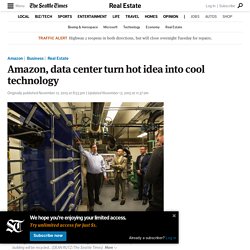
When Amazon.com’s eye-catching spheres and towers open over the next year, the heat for their thousands of tech workers and hundreds of green plants won’t be a drag on the power grid. Instead, the heat for Amazon’s high-rise Denny Triangle campus will be recycled, essentially, from the Pacific Northwest’s telecom hub on an adjacent block — an innovative partnership that could spread to other downtown buildings. Heat coming from the 34-story Westin Building Exchange will be used to warm just over 4 million square feet of development on Amazon’s four-block campus, saving 80 million kilowatt-hours over 20 years, or about 4 million kilowatt-hours a year, officials said Thursday.
Failing phytoplankton, failing oxygen: Global warming disaster could suffocate life on planet Earth. Falling oxygen levels caused by global warming could be a greater threat to the survival of life on planet Earth than flooding, according to researchers from the University of Leicester.
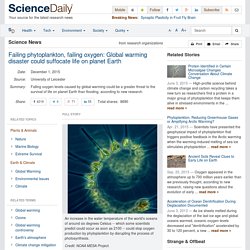
A study led by Sergei Petrovskii, Professor in Applied Mathematics from the University of Leicester's Department of Mathematics, has shown that an increase in the water temperature of the world's oceans of around six degrees Celsius -- which some scientists predict could occur as soon as 2100 -- could stop oxygen production by phytoplankton by disrupting the process of photosynthesis. Professor Petrovskii explained: "Global warming has been a focus of attention of science and politics for about two decades now.
Gates, Zuckerberg and Other Tech Titans Team Up to Push Clean Energy. Bill Gates, Mark Zuckerberg and several other of the world's wealthiest tech and business titans are banding together to fight climate change by investing billions in clean-energy research and technologies.

The Breakthrough Energy Coalition was announced ahead of the opening day Monday of the U.N. -organized climate talks outside Paris. A Carbon Tax for Steak May Be the Best Way to Get People to Eat Less Meat. From renewable energy to carbon sequestration to cap and trade, a lot of different ideas for arresting the change under way in the climate are going to be discussed at the upcoming international climate talks in Paris.
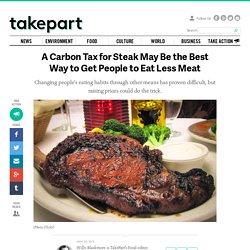
There is, however, one carbon-producing issue that the international group would appear to deem somewhat marginal—only 21 out of 120 national plans included it in their reduction goals—but that could lead to significant cuts in emissions: meat consumption. The problem is, achieving those reductions would require a huge upending of deep-seated habits and cultural norms the world over. The meat industry accounts for 15 percent of emissions globally—equal to the amount of greenhouse gases generated by the world’s cars.
A new report published last week by Chatham House, a policy think tank in London, puts forward an expansive, sometimes aggressive road map for how countries could curb emissions by both encouraging and discouraging people from eating meat. The Koala in the Coal Mine. How to read the jargon at the Paris climate change talks. Maybe climate change tends to take a back seat because the talks themselves are a jargon-filled monstrosity of diplomatic protocol, which means no one — not even the diplomats themselves!
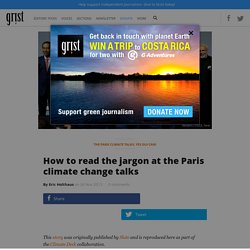
— understands what’s happening half of the time. Here we are, closing out what’s quite possibly the warmest year since the invention of agriculture 10,000 years ago, with our atmosphere’s carbon dioxide at record levels and emissions still rising. Atmospheric Greenhouse Gas Levels Hit Record, Report Says. Photo Global concentrations of carbon dioxide in Earth’s atmosphere surpassed 400 parts per million for a monthly average this past spring, breaching a symbolic barrier set by climate scientists and policy makers, according to a report released Monday.
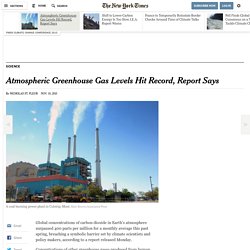
Concentrations of other greenhouse gases produced from human activities, such as methane and nitrous oxide, also reached records in 2014, the World Meteorological Organization announced in its annual Greenhouse Gas Bulletin. The report is one of several measurements made by different climate agencies to address the state of greenhouse gases in advance of the Paris Climate Summit. Borrowing From Solar and Chip Tech to Make Diamonds Faster and Cheaper. Photo Just a decade ago, Silicon Valley had high hopes of becoming a vibrant manufacturing center by making solar panels.

But price competition from abroad, particularly from China, quickly dashed those dreams. Coal Exports and the Terrible, Horrible, No Good, Very Bad Week. And the EV revolution will be led by ... Volvo? Indonesia's Wildfires Are as Bad as Some of the Planet's Worst Air Polluters. Aircraft may be lessening their carbon footprint, but what about airports? Today’s passenger aircraft are becoming ever more efficient, driven by regulations like the EU’s emissions trading scheme and airlines looking to squeeze profit out of every drop of fuel saved.
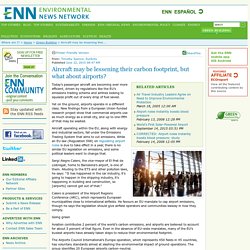
Yet on the ground, airports operate in a different class. New findings from a European Union-funded research project show that commercial airports use as much energy as a small city, and up to one-fifth of that may be wasted. Aircraft operating within the EU, along with energy and industrial sectors, fall under the Emissions Trading System that aims to cut emissions.
Cities Are Banning Cars in Favor of Cyclists and Pedestrians to Fight Choking Pollution. It’s no secret that traffic contributes to poor air quality in urban centers, but it’s now clear that even just one car-free day, such as Los Angeles’ CicLAvia event, can significantly improve the quality of what you’re breathing. Hosted by the nonprofit of the same name in partnership with Los Angeles County Metro and the mayor’s office, a CicLAvia is a one-day event in which streets in a neighborhood of Los Angeles are closed to traffic and opened for cyclists and pedestrians. The last CicLAvia to take place in Downtown Los Angeles was in October 2014; it cut particulate pollution in half compared with normal traffic days, according to a study from UCLA’s Fielding School of Public Health that was published on Monday in the journal Environmental Pollution. There was even a 12 percent drop in pollution in surrounding communities and streets that were still open to vehicles, researchers found.
Are India’s clean energy investments slowing the march of coal? Chinese investment in the Indian renewable energy sector has skyrocketed recently, and construction equipment manufacturer Sany Group is the latest to join the push. The company announced last week that it will direct $3 billion toward the development of at least two gigawatts of renewable energy capacity in India, largely in the states of Maharashtra and Andhra Pradesh. That’s a lot of cash and a lot of capacity, and announcements like these check a solid handful of other sustainable development boxes: expansion of renewables, money flowing between developing countries, private sector partnerships — chalk it up to a win for the climate. Right? Stories of clean energy investment tend to be good news for environmentalists, but in this case, there’s the danger of missing the forest for the banyan trees. The key here is understanding the difference between climate action and pure economic development motives.
Real Returns for Investing in Resilience. As climate change poses greater financial risks to real estate in the form of near-term extreme weather events and longer-term impacts like sea-level rise, developers and owners are increasingly investing in new infrastructure and technologies, innovative design and construction methods, and other resilience strategies not only to protect their properties, but also to create value for their developments, according to Returns on Resilience: The Business Case, released today by the Urban Land Institute (ULI). The Planned Swansea Bay Tidal Lagoon Power Plant Is a Really Big Deal. Just outside the Welsh city of Swansea, the U.K. is planning one of the most innovative power plants ever constructed. A Silent Scourge Is Wiping Out Crops in Africa. A Lot of People Think Sustainability Belongs in the Federal Nutrition Guidelines.
U.S. Reaches Trans-Pacific Partnership Trade Deal With 11 Pacific Nations. ‘Rebuild by Design’ Joins 100RC to Bring Collaborative Research & Design-driven Approaches to Cities. 09.30.15 | By 100RC Facebook Twitter NEW YORK (September 30) – Rebuild by Design, the international design competition tasked with developing innovative plans to protect New York from another Superstorm Sandy, will now join 100 Resilient Cities (100RC), an organization pioneered by The Rockefeller Foundation, to help export the cutting edge program to cities in the 100RC network around the globe. Will California redouble its push for clean energy? It all rides on this upcoming vote. Can capitalism evolve to address the climate crisis?
What We’ve Learned from New Orleans. Nation's water challenges are many, but so are the solutions. The EPA's big crackdown on smog, explained. Volkswagen's appalling clean diesel scandal, explained. Making batteries with portabella mushrooms. Skip the Car Charger: Roads With a Jolt of Electricity Are Coming to the U.K. The Eco-Friendly Approach to Cancer Sticks: Cigarette Recycling Comes to the U.K. It Takes a Shipping Container to Feed a Campus. In times of drought, should I use hand sanitizer instead of washing my hands? Google's making it easy for you to get solar panels onto your roof. Fashion world's antidote to environmental concerns. Chelan & Okanogan Complex Fires Fly Through 8-20-2015 @ 3:30AM. King County becomes largest government in U.S. to use new energy-tracking system used by Microsoft. Improving Our Water Efficiency: The Coca-Cola Company. Vertical #farming coming soon to an #urban area near you with the promise #organic produce using 95% less water.
Here's how new buildings can actually help salmon. The Key to Saving Billions of Gallons of Water is Sitting in Your Shower. Making a Living on the Bayou After a Decade of Disasters. Farmers market vouchers may boost produce consumption in low-income families. Where Are the Highly-Impacted Communities in Washington?
Do You Live in a Resilient City? The home that pays its own utility bill (and then some) Pope Francis convenes world's mayors to discuss global warming. Tuhoe and NZ's first 'living building' Obama Administration Announces Actions to Protect Communities from the Health Impacts of Climate Change at White House Summit. Climate Preparedness Report. Seattle 2030 District Releases New Strategic Plan. Why Everyone Benefits from Energy Efficiency Programs. Enduring Summer’s Deep Freeze. Going Green and Conserving Cash.
Obama's $4bn Clean-Energy Initiative: A Big Number Hiding a Bigger Idea. China Just Made Its Plans To Fight Climate Change Official. 2030 Districts: Communities Collaborating to Reach Inspirational Goals with Measured Performance. Handle with humor: why we want you to laugh about climate change. How to Stop Humans From Filling the World With Trash. 5 Trends Transforming the US Energy Sector. This County In Oregon Completely Banned GMO Crops. Here's Why That Matters For The Environment. California's Gap: Who Gets Permits? Efficiency Technologies Ready To Set Sail. Pope Francis, in Sweeping Encyclical, Calls for Swift Action on Climate Change. Nutella Sparks War Of Words Between European Environmental Ministers. EIA finds wind energy will have largest role in cost-effectively meeting Clean Power Plan.
Waste to Energy Plants on the Rise - Forester Network. New Fund Will Help More Seattle Residents Build Rain Gardens. How Science Denial Derails Scientists. Implementing Stormwater and Erosion Control Best Management Practices - Forester Network. Climate Change Is Helping One Weird Pest Destroy More Crops. Can Technology Save Africa’s Forests?
Ecos PowerCube® - world’s mobile, solar-powered generator for military and di... 4 Years After Fukushima, How Is The Nuclear Industry Faring? California Shows the World How to Stave Off a Climate Catastrophe. Is Seattle a model for sustainable cities, or just a mess? Wind turbines kill fewer birds than do cats, cell towers. Across U.S., Heaviest Downpours On The Rise. VIDEO: How The Energy Industry Can Stay Resilient In A Collaborative Economy. A solar future isn't just likely — it's inevitable. Capracotta, Italy Sets New World Record For Single-Day Snowfall. Solar Streets: New Roadways May Ditch Asphalt for Energy-Generating Sunshine ... Debate on climate change should be over. We're Pumping So Much Groundwater That It's Causing the Oceans to Rise.
Portland Now Generates Electricity From Turbines Installed In City Water Pipes. It Takes How Much Water to Grow an Almond?! Satellite and Information Service (NESDIS) Energy Storage Paves Way for Electricity Independence. Battery Hackers Are Building the Future in the Garage.